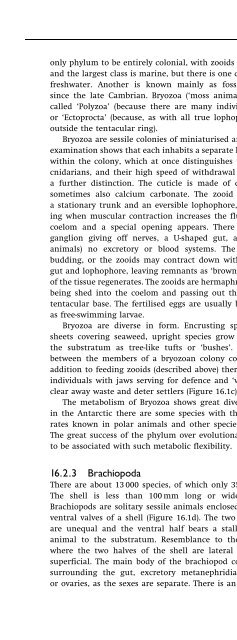An Introduction to the Invertebrates, Second Edition - tiera.ru
An Introduction to the Invertebrates, Second Edition - tiera.ru
An Introduction to the Invertebrates, Second Edition - tiera.ru
Create successful ePaper yourself
Turn your PDF publications into a flip-book with our unique Google optimized e-Paper software.
WHICH ANIMALS HAVE LOPHOPHORES?215only phylum <strong>to</strong> be entirely colonial, with zooids about 0.5 mm long,and <strong>the</strong> largest class is marine, but <strong>the</strong>re is one class that is entirelyfreshwater. <strong>An</strong>o<strong>the</strong>r is known mainly as fossils, very abundantsince <strong>the</strong> late Cambrian. Bryozoa (‘moss animals’) have also beencalled ‘Polyzoa’ (because <strong>the</strong>re are many individuals in a colony)or ‘Ec<strong>to</strong>procta’ (because, as with all t<strong>ru</strong>e lophophores, <strong>the</strong> anus isoutside <strong>the</strong> tentacular ring).Bryozoa are sessile colonies of miniaturised animals. Microscopicexamination shows that each inhabits a separate little ‘box’ of cuticlewithin <strong>the</strong> colony, which at once distinguishes <strong>the</strong>m from hydroidcnidarians, and <strong>the</strong>ir high speed of withdrawal in<strong>to</strong> <strong>the</strong>ir boxes isa fur<strong>the</strong>r distinction. The cuticle is made of chitin and protein,sometimes also calcium carbonate. The zooid body typically hasa stationary t<strong>ru</strong>nk and an eversible lophophore, extended for feedingwhen muscular contraction increases <strong>the</strong> fluid pressure in <strong>the</strong>coelom and a special opening appears. There is a simple nerveganglion giving off nerves, a U-shaped gut, and (in such smallanimals) no excre<strong>to</strong>ry or blood systems. The colonies grow bybudding, or <strong>the</strong> zooids may contract down with regression of <strong>the</strong>gut and lophophore, leaving remnants as ‘brown bodies’ when mos<strong>to</strong>f <strong>the</strong> tissue regenerates. The zooids are hermaphrodites, <strong>the</strong> gametesbeing shed in<strong>to</strong> <strong>the</strong> coelom and passing out through pores at <strong>the</strong>tentacular base. The fertilised eggs are usually brooded, and hatchas free-swimming larvae.Bryozoa are diverse in form. Enc<strong>ru</strong>sting species grow as flatsheets covering seaweed, upright species grow vertically up from<strong>the</strong> substratum as tree-like tufts or ‘bushes’. Division of labourbetween <strong>the</strong> members of a bryozoan colony commonly occurs. Inaddition <strong>to</strong> feeding zooids (described above) <strong>the</strong>re may be ‘bird-like’individuals with jaws serving for defence and ‘whip-like’ ones thatclear away waste and deter settlers (Figure 16.1c).The metabolism of Bryozoa shows great diversity: for example,in <strong>the</strong> <strong>An</strong>tarctic <strong>the</strong>re are some species with <strong>the</strong> fastest metabolicrates known in polar animals and o<strong>the</strong>r species with <strong>the</strong> slowest.The great success of <strong>the</strong> phylum over evolutionary time is thought<strong>to</strong> be associated with such metabolic flexibility.16.2.3 BrachiopodaThere are about 13 000 species, of which only 350 are living <strong>to</strong>day.The shell is less than 100 mm long or wide. All are marine.Brachiopods are solitary sessile animals enclosed by <strong>the</strong> dorsal andventral valves of a shell (Figure 16.1d). The two halves of <strong>the</strong> shellare unequal and <strong>the</strong> ventral half bears a stalk that anchors <strong>the</strong>animal <strong>to</strong> <strong>the</strong> substratum. Resemblance <strong>to</strong> <strong>the</strong> bivalve molluscs,where <strong>the</strong> two halves of <strong>the</strong> shell are lateral and equal, is onlysuperficial. The main body of <strong>the</strong> brachiopod consists of a coelomsurrounding <strong>the</strong> gut, excre<strong>to</strong>ry metanephridia and ei<strong>the</strong>r testesor ovaries, as <strong>the</strong> sexes are separate. There is an open blood system











